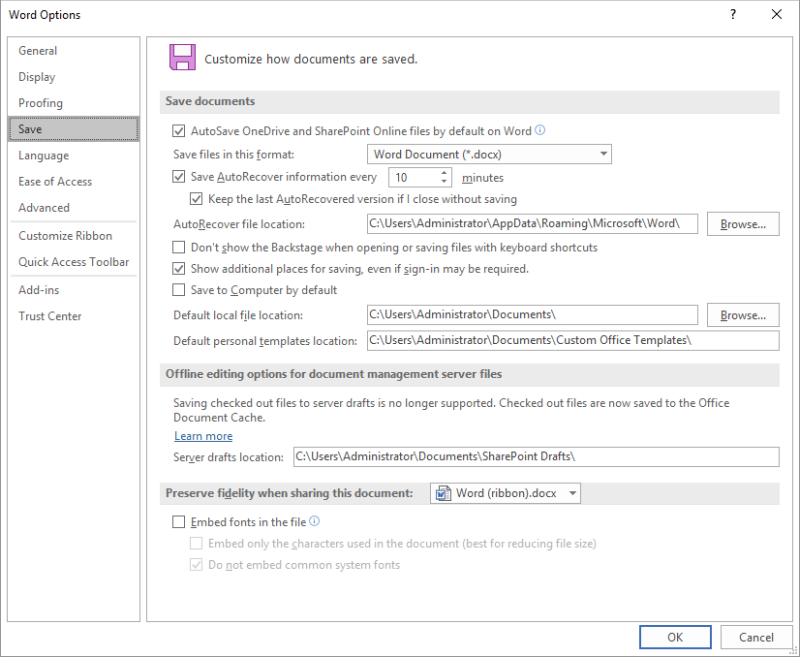Please Note: This article is written for users of the following Microsoft Word versions: 2007, 2010, 2013, 2016, 2019, and Word in Microsoft 365. If you are using an earlier version (Word 2003 or earlier), this tip may not work for you. For a version of this tip written specifically for earlier versions of Word, click here: Embedding TrueType Fonts by Default.
Written by Allen Wyatt (last updated June 9, 2023)
This tip applies to Word 2007, 2010, 2013, 2016, 2019, and Word in Microsoft 365
Like many Word users, Don uses TrueType fonts extensively in his documents. When preparing documents to be used by others, he routinely sets the document to embed TrueType fonts. Since doing this for every document is a bit laborious, Don wondered if there was a way to set font embedding so that it was on, by default, for all documents.
Embedding TrueType fonts is done in this way:

Figure 1. The Save options in the Word Options dialog box.
This setting is persistent for a single document, meaning that when you save a document, the settings related to font embedding are saved with it. Because of this, you can change the setting in a template, and it will affect all the documents that are created based upon that template. Just load the template (even the Normal template), change the embedding options, and save the template.
Remember that this approach affects only new documents based on the template. They will all have the embedding turned on, but existing documents to which the template is attached will not be affected. Why? Because the document already has the font embedding settings turned off, and the document setting overrides the template setting.
There is one caveat to all this—remember that turning on font embedding can increase the size of your documents, sometimes dramatically. If you change a template so that it has embedding turned on by default, this means that all your documents created from that template will be larger than they would otherwise be—perhaps unnecessarily so. You'll need to take pains to turn off font embedding on those documents where it is not specifically needed, in order to minimize document size.
If the main problem is setting the embedding options the way you want, you could create a macro that sets them for you. This would not be a difficult macro, and it could be assigned to a shortcut key or to a toolbar button—one click, and the options are properly set for the document that is open. The following is an example of a macro that turns on font embedding:
Sub EmbedTrueType()
With ActiveDocument
.EmbedTrueTypeFonts = True
.SaveSubsetFonts = False
.DoNotEmbedSystemFonts = True
End With
End Sub
This macro sets all three options related to font embedding. If you want the settings to be different, you can change the True/False settings for each option. (Of course, you'll need to make sure that the EmbedTrueTypeFonts property is always set to True in order to actually embed the fonts.)
Note:
WordTips is your source for cost-effective Microsoft Word training. (Microsoft Word is the most popular word processing software in the world.) This tip (8100) applies to Microsoft Word 2007, 2010, 2013, 2016, 2019, and Word in Microsoft 365. You can find a version of this tip for the older menu interface of Word here: Embedding TrueType Fonts by Default.

Comprehensive VBA Guide Visual Basic for Applications (VBA) is the language used for writing macros in all Office programs. This complete guide shows both professionals and novices how to master VBA in order to customize the entire Office suite for their needs. Check out Mastering VBA for Office 2010 today!
Click the Save button and you expect your document to be saved, right? What if you later discover it wasn't really saved? ...
Discover MoreWord allows you make two types of automatic backups of your documents. One is a copy of the file before you start making ...
Discover MoreSaving documents on a network drive can be convenient. It can also be frustrating if it seems like your changes aren't ...
Discover MoreFREE SERVICE: Get tips like this every week in WordTips, a free productivity newsletter. Enter your address and click "Subscribe."
There are currently no comments for this tip. (Be the first to leave your comment—just use the simple form above!)
Got a version of Word that uses the ribbon interface (Word 2007 or later)? This site is for you! If you use an earlier version of Word, visit our WordTips site focusing on the menu interface.
Visit the WordTips channel on YouTube
FREE SERVICE: Get tips like this every week in WordTips, a free productivity newsletter. Enter your address and click "Subscribe."
Copyright © 2024 Sharon Parq Associates, Inc.
Comments